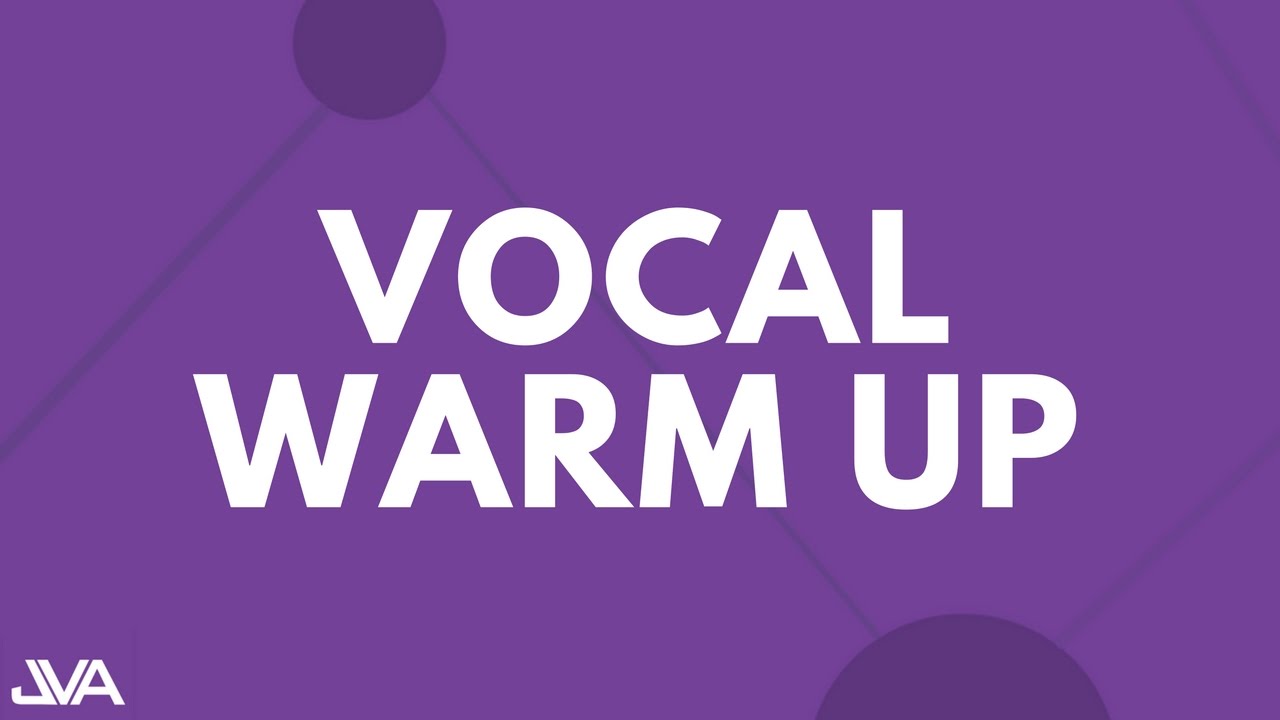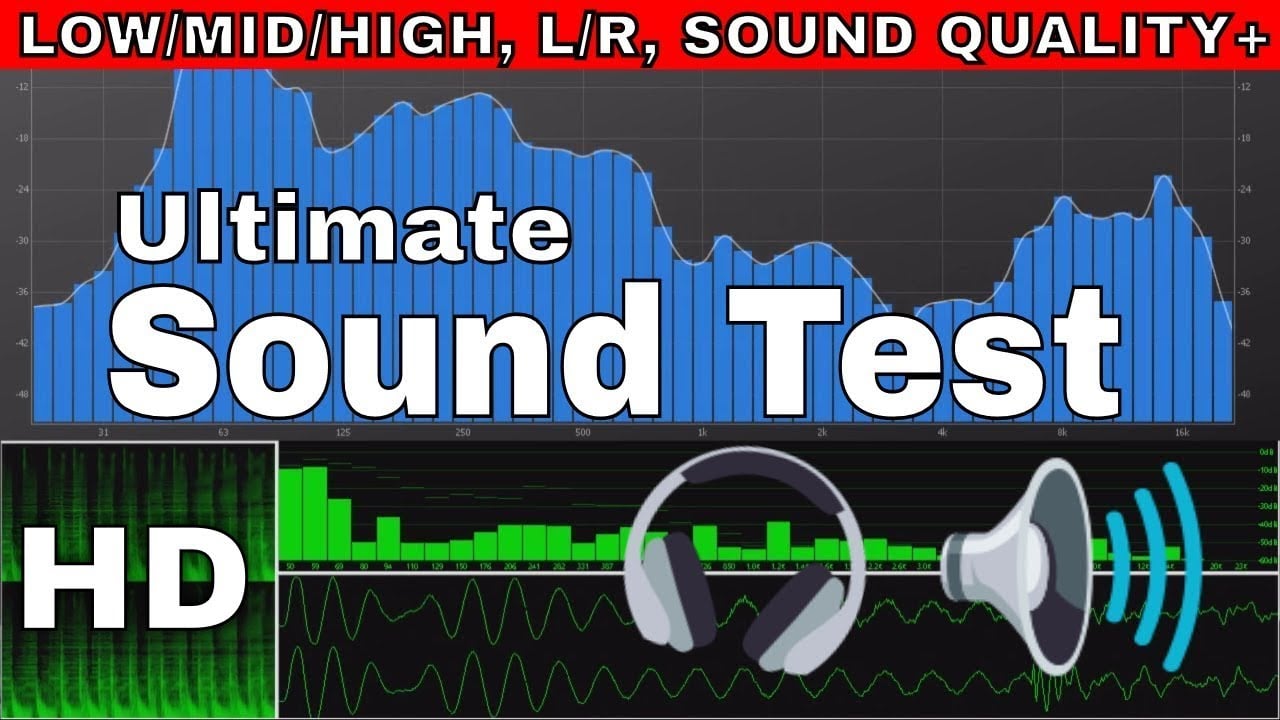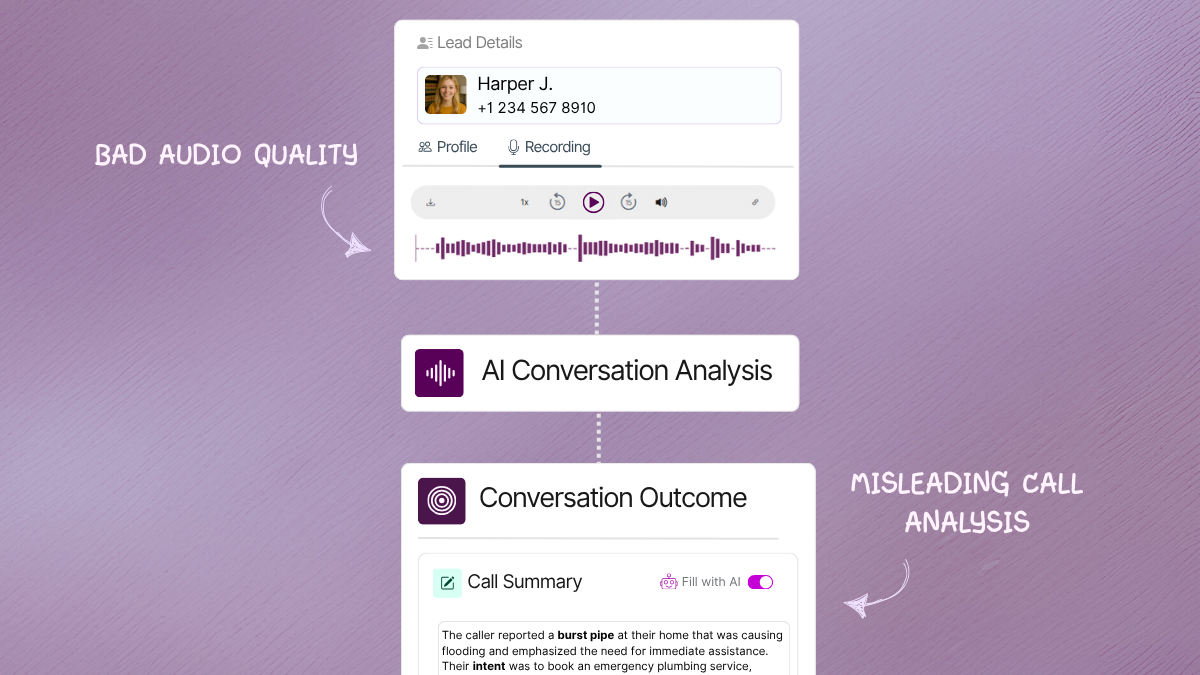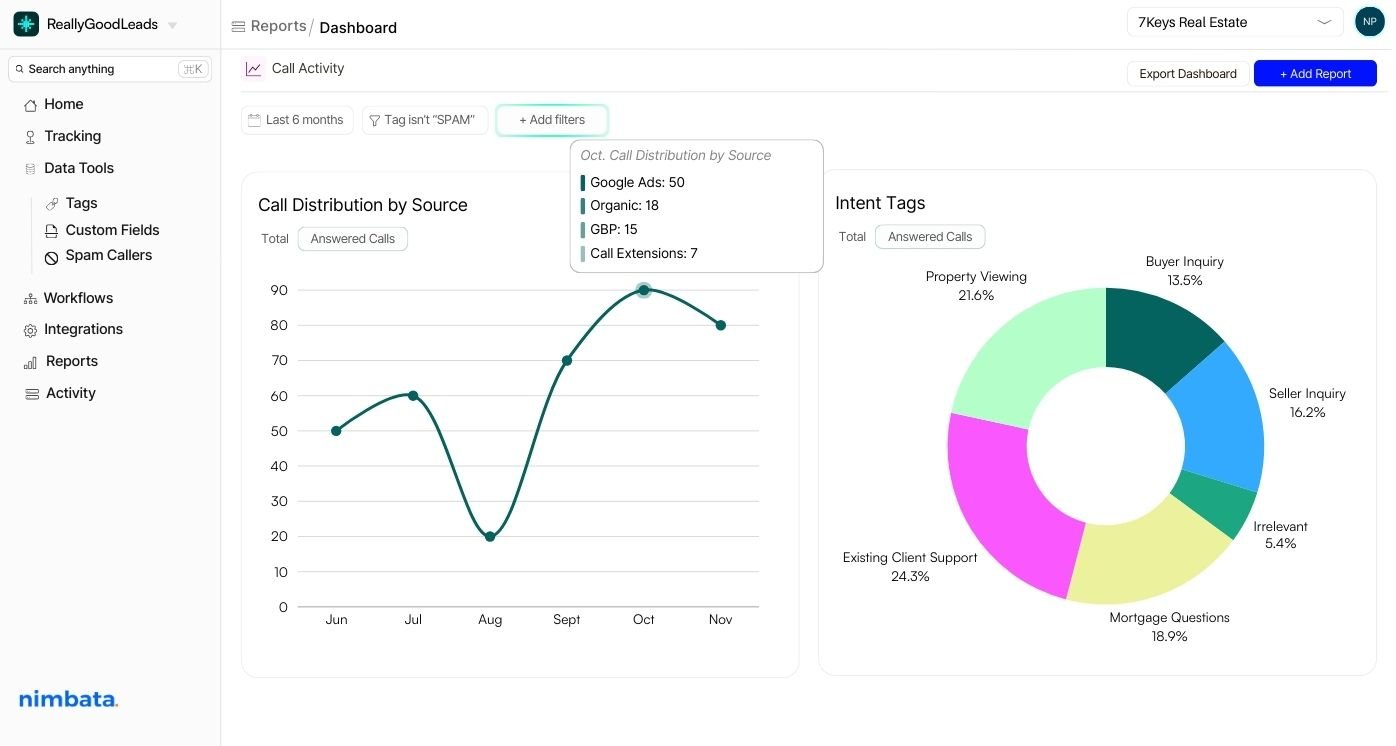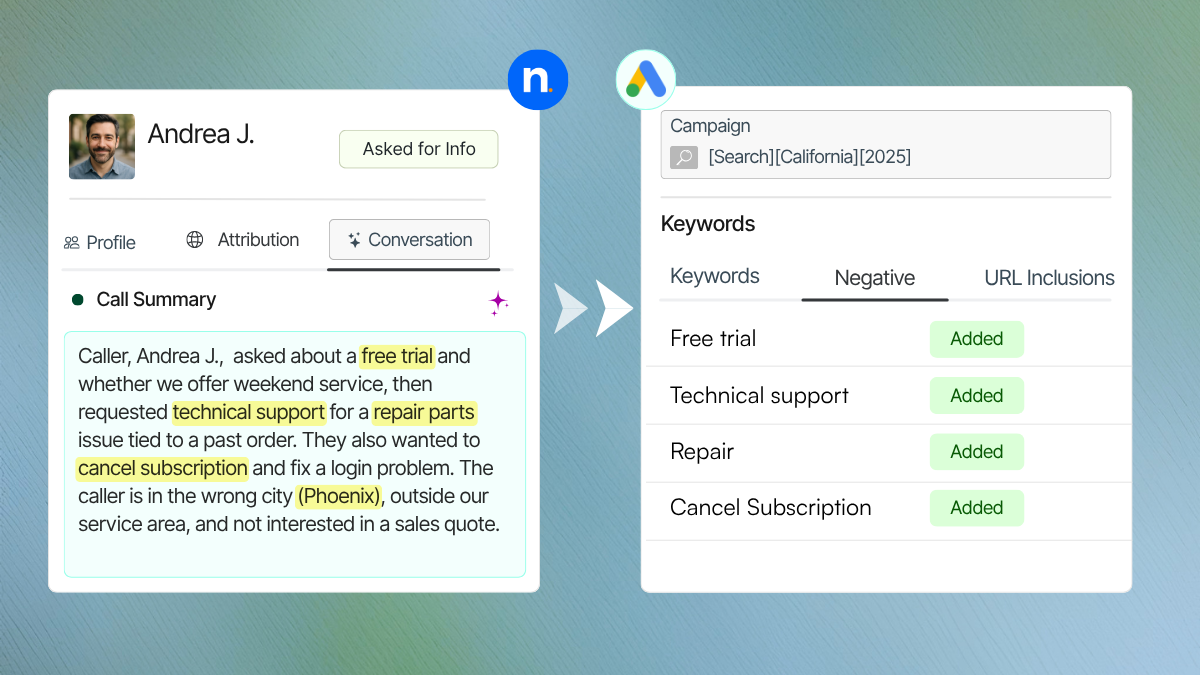The role of audio quality in AI call summaries, notes, ratings, and value
AI tags and ratings come from transcripts. If the audio is unclear (because of a noisy environment, inadequate noise cancellation, or minced words) or corrupted (because of slow internet connectivity or damaged audio equipment), then the transcript that’s generated will also, naturally, be unreliable. This issue then trickles down to audio-analysis software applying the wrong tags and ratings, and mislabeling poor-quality calls as conversions.
When you fix your audio recording at the source, the quality of your data also increases:
- Transcripts become accurate and your summaries make sense
- Tags and ratings improve so your qualified rules work as intended
- Only good calls count, which trains Google’s algorithm for lower CPA and higher SQLs
10 things you can do now to improve audio recording quality
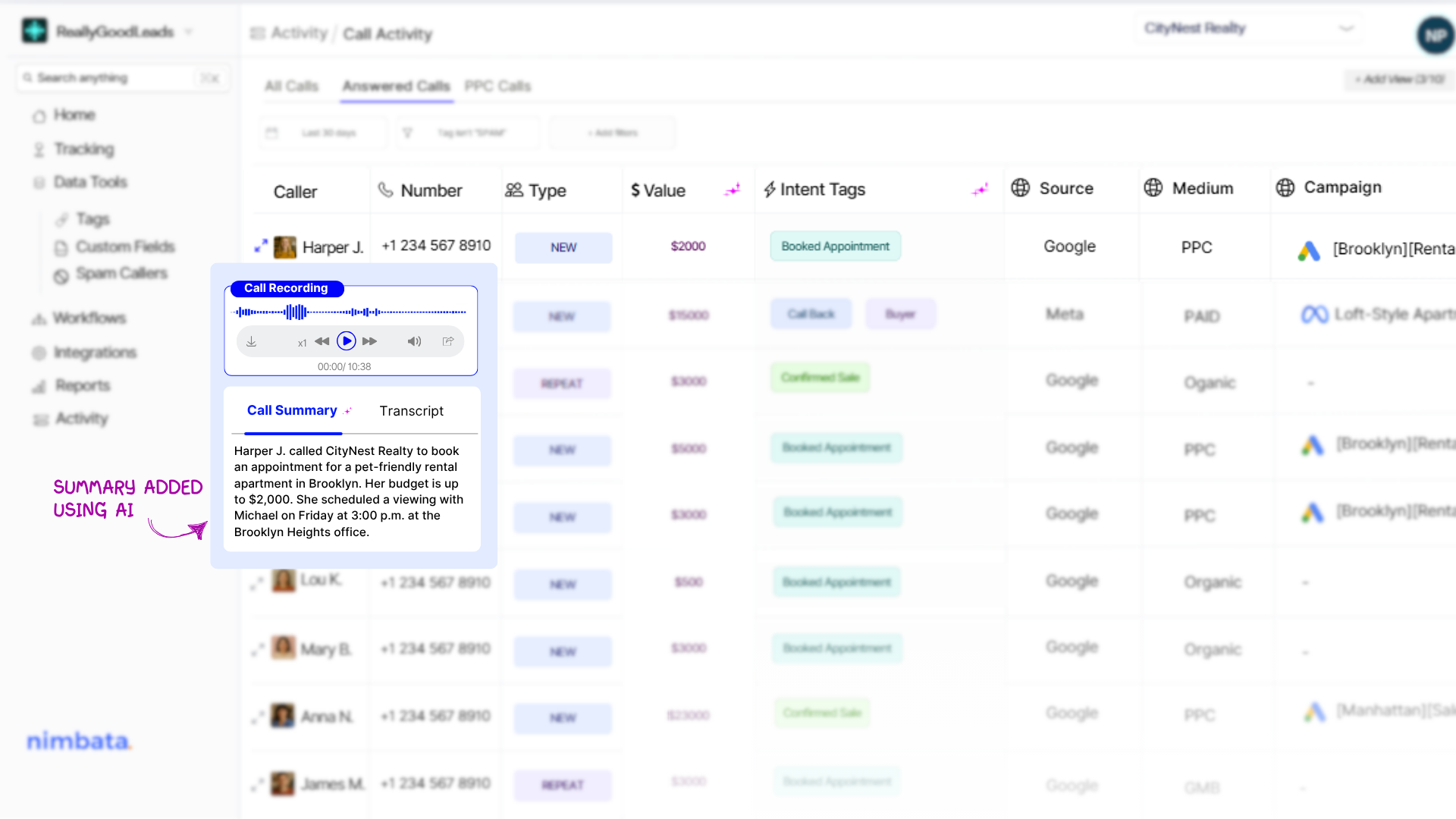
Good recordings mean the quality of your audio is crispy clear so every word is captured correctly. There are many tips and guides out there on how to improve your audio. After testing their effectiveness, we’ve gathered all the advice that worked for us below:
1. Get rid of the speakerphone
Opt for a wired headset or quality USB headset instead. Such devices generate less of an echo and reduce room noise with their use of noise-cancellation technology.
2. Reduce environmental noise
Make sure to shut any open doors and windows, move away from fans, A/C units, or any other device that produces constant noise, and avoid recording in open lobbies or large rooms with high ceilings, as those are prone to sound amplification that messes with how audio is recorded.
3. Speak with clear diction
Even the most advanced audio analysis software may struggle with accuracy if you mince words. Speak in a loud, clear manner, and be vigilant about your pronunciation. Even better, animate your speech by putting the right vocal emphasis on the most pertinent points you want to make.
4. Have a clear and consistent greeting
The first sentence you utter should state your business, location, and purpose, i.e. ‘Thank you for calling Nimbata customer service, Athens. How can we help?‘. In this way, your AI software will lock onto the call’s intent faster.
5. Ask one qualifying question early
“Are you a returning customer or a new one?” Doing so helps anchor tags and ratings right from the start. While this is not a direct contributor to audio quality per se, it can help mitigate some of the clarity issues that can surface from poor audio recording quality.
6. Select the device and record from the right distance
First, consider whether you need a microphone stand, test different types of microphones to find the one that works with your equipment best, and place it two to three centimeters from mouth. Be careful to keep your speaking volume steady and avoid shouting, and check that your microphone is not rubbing against clothing.
7. Use audio recording software
This type of software lets you improve the audio quality of your recordings by allowing you to adjust audio settings such as equalization, sample rate, bit depth, and channel count. Post-production processing settings can clear out muffled or loaded calls into clear, AI analysis-friendly recordings.
8. Record uncompressed/lossless audio
The best audio quality comes from recordings that are free of compressions, edits, and losses in audio quality resulting from cross-platform, cross-software, and cross-device audio file transfers, or, most often, from technical restrictions that prevent you from recording in your desired audio quality level. Set your audio recording software to the highest quality setting available and let it work its magic.
9. Use a pop filter
One of the worst offenders of poor audio quality out there is the way most people pronounce plosives. In phonetics, plosives are voiced (d, g, b) and voiceless (t, k, p) speech sounds made with the tongue tip or blade, tongue body, lips, or glottis that block the vocal tract when pronounced, and lead to airflow being ceased. Pop filters are a type of extra-sensitive audio equipment that can pick up these sounds and maintain your audio recording’s integrity.
10. Warm up your voice
Last but certainly not least, this one may sound like a no-brainer, but it’s worth mentioning. Dedicate five minutes before your calls to perform some vocal warmup exercises. They are a must if you want your pronunciation and intonation to be in top shape. Preparing your mouth and throat for speech will help you sound both clearer and more animated. This, in turn, will improve the accuracy with which your software picks up what you say.
Looking for exercises to help you warm up your voice? Then, check out the video below:
How to test your audio quality so it translates to better AI analysis quality
Now that you’ve set yourself up for success, it’s time to test your equipment, environment, and software on its effectiveness. Do the following:
1. Place 3 test calls
While we recommend that you take calls in a quiet environment, the reality of it is that you may often have to record calls in less-than-ideal circumstances. Preparation is the key to success here, so running some test calls in different settings will help you gauge the effectiveness of your equipment, software, and analysis of the recordings by your AI tools. Pilot some calls in a quiet office room, then a main office space with regular sound levels, and then go to a noisy lobby to see how your setup performs against the toughest of recording conditions.
2. Check transcripts, summaries, and tags/ratings
a) Transcripts
Is all the information you need to capture during a call, such as name, address, location, reason for the call, and any quoted amounts captured correctly and accurately?
b) Summaries
Do they accurately reflect what was discussed, agreed upon, and emphasized on during the call? Is the purpose of the call clear to someone reading the summary who wasn’t in the call and hasn’t listened to the recording?
c) Tags/Ratings
First, look at the transcript and summary of a call, then listen to its recording. Do the tags correspond to the intent of the call? Does the quality of the call match the rating assigned to it by your software?
3. Fix any issues that reoccur and test again
Play around with your audio settings (wired vs wireless headset vs no headset), your environment (close doors and windows), and experiment with introductory call greetings until your software captures and analyzes calls as it should. Feel free to keep refining your approach as many times as necessary until you get the best results possible.
Watch the video below for a thorough explanation and walkthrough on testing your audio quality:
4 routing tricks to improve audio clarity and quality, leading to more qualified calls
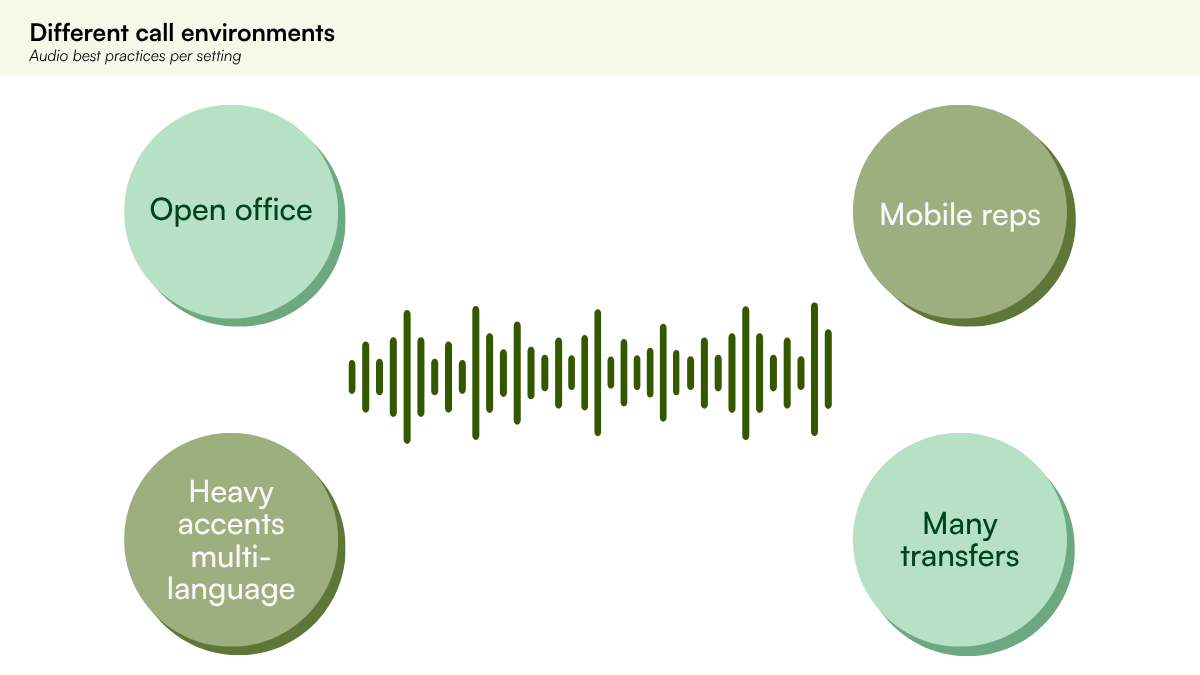
Audio quality is often influenced by the length, pauses, and callers involved in a recording. Think speaking to a representative in a quiet, controlled environment, only to be rerouted to one in a busy office where you can clearly hear auditory interference. Multiple languages and locations may also hinder effective call analytics unless you manage them properly. Here are four tips to get the best results:
1. Language routing
Not everybody speaks English. In the case of first-time callers especially, be mindful about detecting the language that your interlocutor speaks in or asking them to state what language they speak explicitly so that the software can switch its settings accordingly. Misheard or wrongly-identified languages can ruin transcripts and wreak havoc to call intent.
2. Time-based routing
Success comes from setting up different routing options based on the time of day and day of the week. If your business hours are between Monday and Friday from 9am to 5pm, then send all calls during those days and hours to live agents. For evening, night, and weekend callers, use a voicemail plus callback routing option so you can get back to them promptly.
3. Geo routing
Next up on your list of smart tasks is to route callers to the right location and team. Transcripts of calls where wrong routing occurs can be confusing to say the least – and we’re being very kind with our choice of words here. AI call analysis software can often flag calls as coming from the wrong region if it detects an otherwise incorrect number prefix and, consequently, the if other languages than the target ones are spoken during the call.
4. Overflow rules
In cases where you’re short on call agent staff or the volume of calls is simply too high, it’s preferable to set up sequential ringing, aka to automatically reroute a caller after 3 rings to the next preselected agent or backup group, than to subject callers to long hold times. When callers wait on the phone for a long time, they tend to talk to themselves, sometimes in different languages, and about different topics; this type of input destroys audio quality and degrades call intent.
5 metrics to measure the quality of your recordings
Now that you’ve fixed what’s wrong with your audio, ran your tests, and set up super-smart routing using our tips, here’s what you need to measure to gauge whether the quality of your recordings meets your standards:
- Transcript match rate (spot-check 5 calls/week): names, numbers, city captured?
- Tag accuracy (% of calls correctly tagged ‘Sales’ vs ‘Service’)
- Qualified rate (qualified calls ÷ all calls) -> should rise
- CPQC (spend ÷ qualified calls) -> should fall
- Missed-call % & median callback time -> cleaner operations = clearer outcomes
E.g. Before: transcript errors on 30% of calls; qualified rate 38%.
After 10-minute fixes: transcript errors 10%; qualified rate 55%; CPQC falls without touching media budgets.
The better your audio quality, the better your AI analysis
Crystal-clear audio is the foundation of your entire AI performance stack. When your input signal is flawless, your AI system does not need to guess. It hears correctly, labels correctly, scores correctly, and most importantly teaches your ad platforms correctly. And all of this happens without touching your media budget, funnels, or scripts. It happens simply by fixing signal quality at the source.
The takeaway is simple – bad audio silently taxes every AI insight you depend on. Good audio compounds across every downstream metric you care about. Once you lock in clean signal, your summaries improve, your tags improve, your qualification improves, and your growth engine automatically gets smarter with every call.
Your AI is only as good as what it hears.
Make sure it is listening to your best.
Your call tracking tool
doesn’t have to suck!
Flexible Product, Expert Support, Transparent Pricing.
